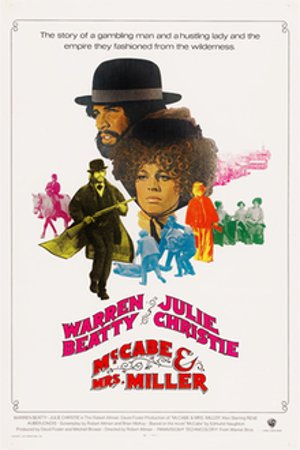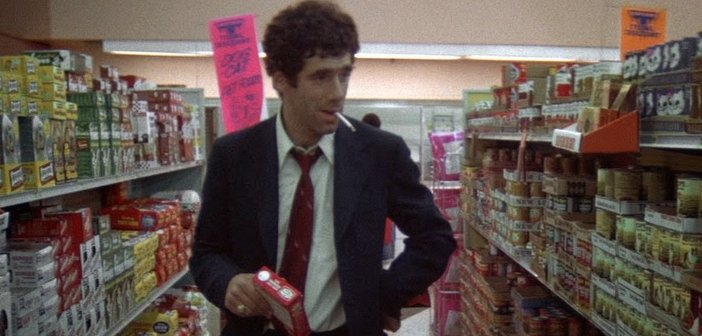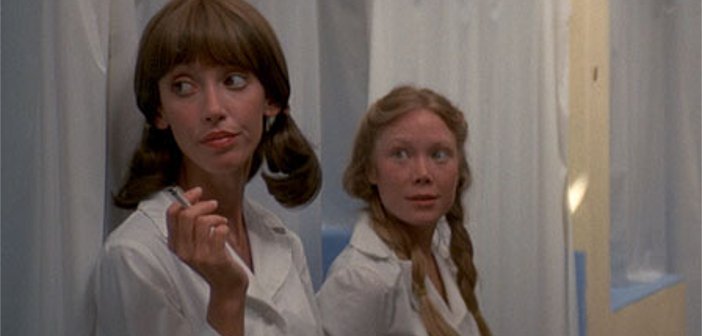Director Profile | Robert Altman: An Unconventional Storyteller
In honour of the late and great filmmaker Robert Altman, whose 10 year anniversay falls this weekend, November 20th, this director profile will highlight some of his best works.
Despite being a five-time nominee of the Academy Award for Best Director – MASH (1970), Nashville (1975), The Player (1992), Short Cuts (1993) and Gosford Park (2001) – Altman is perhaps most notable for his reputation of being “anti-Hollywood”. A major figure of the American New Wave cinema of the late 60s and 70s, his cinematic output subverted the heavily stylised Hollywood films that came before, occasionally critiquing them. Although he worked in virtually every genre – Western (McCabe & Mrs. Miller), crime (The Long Goodbye), comedy (The Player), sci-fi (Quintet), drama (3 Women) and thriller (Images) – most his films are linked by a realist style, favouring naturalism. Altman pioneered various filmmaking techniques and despite not being as well-known as other American New Wave figures like Allen, Coppola, De Palma and Scorsese, he has influenced many modern directors. The most obvious example is Paul Thomas Anderson – who worked on Altman’s final film A Prairie Home Companion (2006).
[arve url=”https://www.youtube.com/watch?v=WFiXAgwuaJI” mode=”normal” align=”center” autoplay=”no” maxwidth=”750"]
McCabe & Mrs. Miller (1971)

An early example of a revisionist Western, McCabe & Mrs. Miller rejects both the romanticised Hollywood take on the oater, popularised by John Ford, as well as the later stylised “Spaghetti” variation by Sergio Leone and Sergio Corbucci. Set to the music of Leonard Cohen, the film begins with the titular McCabe (Warren Beatty), a mysterious gambler wandering into the town of Presbyterian Church. Teaming with Mrs. Miller (Julie Christie), a British madam, McCabe establishes a brothel and the two begin to reap the profits. Their elation is, however, interrupted by the arrival of Butler (Hugh Millais), a bounty hunter for a large mining company who will stop at nothing to secure the protagonists’ land.
McCabe & Mrs. Miller feels grittier and more historically accurate than a typical Western. In terms of place, Altman bypasses the picturesque sun-drenched landscape of most oaters, in favour of a beautiful but snowy and dreary Northwest America setting. The town of Presbyterian Church, rather than being filled with glamorous retro saloons, is constantly under construction, capturing onscreen the effort that must go into building a village. Meanwhile, Altman, who also adapted the script from Edmund Naughton’s novel, creates characters who feel real, as opposed to the archetypes that appear in Leone’s cinema. The director’s fly-on-the-wall anti-narrative style – where he will take breaks from the main story to observe the lives of the side-players – helps generate a feeling of community bound by the central brothel. As David Milch, who drew upon Altman’s film for his HBO series Deadwood, notes, all the characters are linked by their use of intoxicants to provide a form of anaesthetic from the boredom. Meanwhile, McCabe is the furthest thing from a Clint Eastwood-esque hero. While one believes, at first, he falls under “the drifter trope”, he is much more three-dimensional. McCabe is an ambitious fool who uses his bravado, as well as the brains of Mrs. Miller, to conquer the one-horse town. However, this isn’t enough to help him battle bigger threats, leading to his demise. Again, unlike Eastwood, Beatty’s character attempts to outsmart his enemies by hiding – rather than stoically standing up to them as Western heroes generally do.
[a[arve url=”https://www.youtube.com/watch?v=cb4dxubPYEs” mode=”normal” align=”center” autoplay=”no” maxwidth=”750"]p>
The film has had a strong legacy. As well as being one of the first to utilise over-lapping dialogue – helping to realistically elicit on-screen the sensation of being in a crowded bar – it was a huge influence on Paul Thomas Anderson’s There Will Be Blood (which is dedicated to Altman). Both movies are anti-capitalist revisionist Westerns and can be interpreted as two sides of the same coin. In McCabe & Mrs. Miller, McCabe is an entrepreneur crushed by a literally faceless corporation – we never meet Harrison Shaughnessy, Butler’s boss and the head of the villainous mining company. There Will Be Blood, on the other hand, is told from the perspective of the major tycoon exploiting and buying out small businesses. Also, in McCabe & Ms. Miller, there is a sub-plot regarding the partnership that turns sour between McCabe and his weak but sly original partner Sheehan (Rene Auberjonois). Watching now, one could interpret this as the genesis for Daniel Plainview’s relationship with Eli Sunday in Anderson’s picture.
The Long Goodbye (1973)

Another example of its director taking the formula of older cinema and doing something revelatory with it, The Long Goodbye is an adaptation of one of Raymond Chandler’s famed novels centering upon private investigator Phillip Marlowe. An incredibly likable Elliott Gould (who was one of Altman’s regulars, starring also in MASH and California Split) plays the gumshoe that attempts to discover a link between the murder of a rich playboy and personal friend’s wife, a missing alcoholic writer (the great Sterling Hayden channeling Hemingway) and a vicious gangster (Mark Rydell).
Before The Long Goodbye, the most significant Marlowe adaptation was 1946’s The Big Sleep starring Humphrey Bogart. Directed by Hollywood royalty Howard Hawks, the film is in love with the medium of cinema, using it to create an intoxicating stylised world where its central P.I. is always the coolest but also most moral character in the room. The Long Goodbye, written by Leigh Brackett (who also wrote Hawks’ movie), with uncredited contributions by Altman, is where this previous façade of cool begins to crack. Taking place in 70’s California, as opposed to the early 50’s setting of the novel, it depicts, through its deliberately faded cinematography by Vilmos Zsigmond, a world where the glory days of Hollywood have declined.
Although minor older characters reference warmly the classics such as Double Indemnity, the film highlights the negatives of a society driven by celebrity. The rich and famous with which Marlowe becomes involved are depicted as greedy, self-centred and wealth-obsessed. The P.I., who previously was portrayed as so suave and intelligent, is now fooled by his supposed friends into doing their dirty work, while they secretly think of him as a “born loser”. Altman reinforces this relationship dynamic by setting up Marlowe as a cat lover – he uses the name “Mr. Katz” when secretly investigating. Meanwhile, the people who employ his services own large dogs which are constantly barking at the P.I. – foreshadowing his impending victim status. Incredibly, the movie captures the disillusionment with Hollywood that led to new filmmakers like Altman challenging such a system.
3 Women (1977)

Another of Altman’s films to ignore the touchstones of classical Hollywood storytelling – cause and effect narratives, easy to read characters, resolute endings – 3 Women highlights the impact European cinema had on the director. Inspired by Ingmar Bergman’s Persona (1966), the film tells the tale of two women who are co-workers named Millie. One is young, timid and awkward (Sissy Spacek), while the other is older, talkative and confident (Shelley Duvall – who won Best Actress at Cannes for her role). They begin to share a flat together but their personalities clash, while a third mysterious woman (Janice Rule) becomes involved in their ongoing feuds. Following a violent event, the power dynamic between the Millies changes, leading to them gradually switching character traits.
Slow and deliberate but creepy and unsettling, 3 Women is a film which is, at times, difficult to watch but stays with the viewer days after watching, burrowing under one’s skin. Altman employs his trademark realism in the first half to create a world the audience believe in. This then makes the sudden shift into dreamy intangibility in its second all the more unnerving. For example, the scene where young Millie, following an accident, is visited by people who claim to be her parents, despite her violent protests that they are imposters.
Despite being embraced by the art crowd, it was ignored by American audiences. However, along with Persona – which also deals with the fluidity of identity and features a central violent act which breaks the film into two – 3 Women has achieved a cult following and has gone onto inspire a wave of women-centred personality swapping psychological thrillers such David Lynch’s Mulholland Drive, The Duke of Burgundy and most recently, Queen of Earth.
The Player (1992)
Whereas The Long Goodbye critiqued the film industry implicitly, Altman’s adaptation of Michael Tolkin’s novel does it explicitly. The film centres upon Griffin Mill (Tim Robbins), a Hollywood studio executive. While juggling a non-commercial but promising script and an up-in-comer story exec (Peter Gallagher) gunning for his job, Mill begins receiving poison pen letters from a struggling writer whose pitch he rejected.
[arv[arve url=”https://www.youtube.com/watch?v=dwnhRRRQtaI” mode=”normal” align=”center” autoplay=”no” maxwidth=”750"]
A marvelously executed eight-minute opening tracking shot, which zips between various professionals working in the industry (one of whom is bemoaning the lack of long takes in films today) – sets the tone for this witty and self-aware picture. Throughout Altman and Tolkin, who adapted his own novel, satirise how Hollywood studios produce their content. Executives are depicted as getting their writers to pitch their scripts as quickly as possible, leading to interactions like: “so it’s a psychic political thriller comedy with a heart … Yes! Think Ghost meets Manchurian Candidate”, and believing the idea that “slapping a happy ending” on everything will appeal to mass audiences. What is truly amazing is how many actors and actresses Altman managed to persuade to send-up their public image in his movie. The finale of the compromised film within a film starring Bruce Willis and Julia Roberts (playing themselves) is a hilarious and painfully accurate depiction of dumb cinema.
Short Cuts (1993)

Following a string of commercial failures in the late seventies, Altman left Hollywood and began directing independent adaptations of plays to varying degrees of success. However, following the acclaimed reception of The Player, both critically and financially, the director seized his new-found marketability to produce arguably his most ambitious film – Short Cuts. Based upon nine short stories and a poem from legendary writer Raymond Carver, the three-hour movie revolves around a group of people living in L.A., seemingly unknown to each other, whose lives interconnect both subtly and violently over the course of the drama.
Short Cuts feels like a culmination of Altman’s various sensibilities. Carver’s recurring theme of violence against women is something which has always lurked in the background of the director’s work – as evident by the prostitutes of McCabe & Mrs Miller, the gangster’s moll whose face is smashed with a glass in The Long Goodbye or the adulterous husband of Janice Rule’s character in 3 Women. Also, the movie once more sees Altman returning to an L.A. setting and providing a glimpse into the unhappy lives of those who occupy it. Plus, to a lesser degree, Short Cuts, like much of its director’s filmography, criticises the entertainment industry with Robert Downey Jr.’s make-up artist character using his miniscule status in Hollywood to seduce younger starry eyed women.
[arve [arve url=”https://www.youtube.com/watch?v=YK_PoMY0MOw” mode=”normal” align=”center” autoplay=”no” maxwidth=”750"]p>Like 3 Women there is very little clear resolution. Short Cuts instead leaves its viewers to form their own interpretation as to what the film is about. One can read it as a movie about fate and how strangers can play such key roles in our lives without realising it. Another could argue the complete opposite and state that the film is about missed connections e.g. Tim Robbins’ adulterous police officer (who appears to get off on his lies, rather than the sex itself) could curb his addiction with the help of Jennifer Jason Leigh’s phone sex operator but they never meet. Either way, it’s clear that Short Cuts, along with Pulp Fiction which came out a year later, kick-started the “multiple stories interconnected” sub-genre of movies like Magnolia (another connection between Altman and Anderson), Happiness, Traffic, Crash and Babel.
Order to watch
- The Player
- The Long Goodbye
- McCabe & Mrs. Miller
- 3 Women
- Short Cuts
Also worth checking out
One thing that perhaps held Altman back from achieving the same levels of acclaim as his contemporaries is his patchy filmography, which, all throughout his career, is riddled with duds (Quintet, Popeye, Beyond Therapy, Pret-a-Porter) – perhaps a result of his mantra “to play it safe is not to play”. However, much of his output outside of the five I discussed is heavily lauded. MASH, Nashville and Gosford Park are Academy Award Best Film Nominees while California Split and Images are generally considered underrated classics. Occasionally, even some of Altman’s less successful work (e.g. his adaptation of Sam Shepard’s play Fool for Love) is worth a look just to see the director experimenting with the cinematic form. Perhaps, if the majority of talented filmmakers took the risks Altman did – critiquing or subverting the Hollywood system, experimenting with new technologies – cinema today would be far more daring and innovative.

